Editing tools
Selector tool
The Selector Tool is the default. It can also be selected using O on the computer keyboard. The cursor shape in this mode varies depending on where it's placed and what you're doing. This is described further in the section on Selecting Blocks.
Cutter tool
The Cutter tool is used for breaking pitch blocks into sub-blocks so that the pitch can be tracked and modified more finely with respect to time. It is selected using the contextual menu or by pressing I on the computer keyboard. The cursor appears as a knife that can be applied at any point within a pitch block to break it. The vertical red line moves with the knife cursor to identify the exact position at which cuts will take place.
The result is two separate pitch blocks, each with a tracked pitch related only to that section of audio as shown.

becomes... 
The same tool can be used to Split Pitch Limits if you have Edit Pitch Limits selected as the editing mode. In this mode if you open the contextual menu you will see a slightly different set of options, but the same keyboard shortcut for the Cutter tool applies:
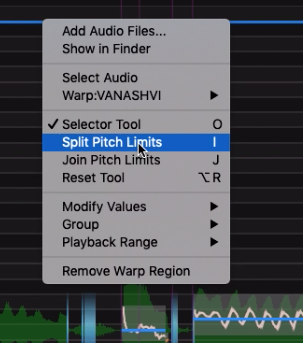 then apply the tool to the pitch limit line
then apply the tool to the pitch limit line 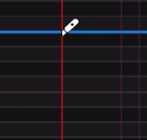 and click to create a split,
and click to create a split, 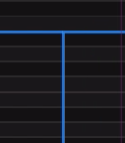
...after which the pitch limit of each region can be changed independently as shown below:
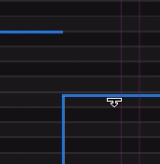
The Join Pitch Limits (J) operation can be used to join previously split pitch limit regions in this mode, while the Reset Tool (opt/alt-R) can be used to reset all the pitch limits to their initial value.
Pencil tool
The Pencil tool allows you to draw pitch contours. It is selected using the contextual menu or by pressing L on the computer keyboard. The cursor appears as the symbol shown, and can be applied by holding down the left mouse button and dragging between notes, at the desired pitch, to draw a new pitch contour. The tool only modifies the pitch values of blocks that exist. It cannot introduce pitch points where none was identified originally.
The result is a new pitch contour and pitch blocks that correspond to this contour.
 becomes...
becomes... 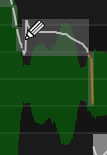
Warp point tool
The Warp Point tool allows you to add and delete additional time warping points. It is selected using the contextual menu or by pressing . on the computer keyboard. Additional warp points can be added by shift-clicking at any point on a track, or deleted by shift-clicking on an existing warp points.
Correct pitch tool
The Correct Pitch tool pulls in the pitch of selected notes towards standard pitch centres (notes of the chromatic scale). It is selected using the contextual menu or by pressing K on the computer keyboard. The cursor appears as the symbol shown, and can be applied by holding down the left mouse button and dragging across the note range to be corrected.

If the notes are already selected, just choose the tool and adjust the pitch as explained below.
A slider appears allowing control over the amount of automatic pitch correction from 0–100%.

Holding down option/alt and clicking on the slider will set it to 100%. When at 100% all notes in the selection will be completely pulled to the nearest pitch interval, but lesser strengths of correction can be set. Automatic pitch correction is applied on top of any manually applied changes. Revoice Pro remembers the pitch corrections applied to notes, so if they are selected again with this tool the previously set pitch correction value will also be shown and can be modified.
If the Correct Pitch tool selects notes having different amounts of previously applied pitch correction, the control slider will show the range of correction strength applied to those notes, and the slider will be set midway in this range. Changing the slider, however, will pull all notes selected to the single newly applied value.

If a specific musical scale is selected in the Scales menu at the bottom right of the main window (transport area), then this function will correct the pitch only to notes of the selected scale. The scale most relevant to the current audio region can be automatically detected by pressing the D key or selecting Detect Scale from the contextual menu. See the chapter Musical Scales for further information.
NOTE: Automatic pitch correction is a mathematical operation - based on how the waveform "sits" within a note range. There is no perceptual model used, so the user should always check all automatic pitch correction by ear as some notes from corrected pitch contours will not sound exactly in tune and will need user adjustment.